Day 2 of a long weekend of Spring Migration tours today. This time we headed east along the coast, starting the day with our first stop at Kelling.
As we walked down along the track to the Water Meadow, a Lesser Whitethroat was singing from the dense blackthorn. We could just see it hopping around in the branches as it sang. Down by the copse, a Chiffchaff was singing too. We had good views of that as it sang in a small tree and a second Chiffchaff flew back and forth across the path at the same time.
We got down to the gate overlooking the Water Meadow and could feel the cold and blustery north wind in our faces. A Brown Hare was hunkered down on the edge of the grass in the shelter of a dense clump of rushes. At this point, we could see dark shower cloud approaching, so we too shelter behind the hedge. Thankfully, it quickly passed over us on the breeze.
Looking over the brambles, across to the field the other side, we could see a Ring Ouzel out on the short grass. We got it in the scope and could see its white gorget. A second Ring Ouzel appeared nearby. A female Wheatear appeared in the same field. There are quite a few Common Whitethroat which have arrived in the last few days and there were lots around Kelling now. One particularly obliging individual landed in the brambles beside us singing. It proceeded to song flight, hovering above our heads at one point, and perching on various bushes.
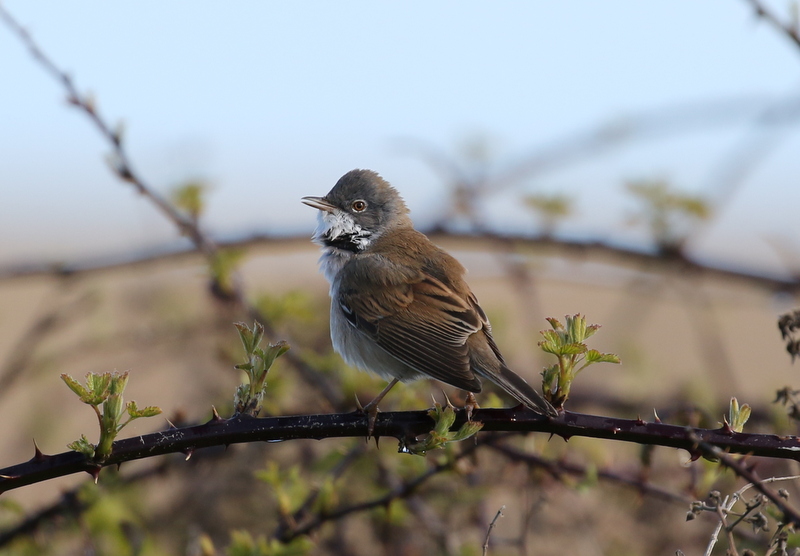 Common Whitethroat – this one performed very well right next to us
Common Whitethroat – this one performed very well right next to us
There were a few ducks out on the pool. Several Shoveler were swimming round in circles with their heads under the water feeding. Three Teal were hiding down in the vegetation on the near bank. The pair of Egyptian Geese still have four goslings so far, and they are growing steadily now. There were a couple of Avocet on here too. From round the other side, we could see a single Common Snipe. It was extremely well camouflaged, sitting tight up against the rushes, and very hard to see until it finally moved out a little.
As it brightened up a little, first a Swallow appeared, zooming back and forth low over the path, and then several Sand Martins. They all began to hawk for insects low over the water.
It looked like the Ring Ouzels might be showing much closer from the path over the other side, but by the time we got round there they had been flushed by several people standing by the edge of the field and flown to the hedge further down along the Water Meadow. We could see them perched up in the top of a bush briefly, before they dropped down out of view. We contented ourselves with watching a nice pair of Stonechats instead as they fed from the fenceposts or small dead thistles out in the field.
 Stonechat – a pair were feeding in the corner of the field
Stonechat – a pair were feeding in the corner of the field
We had a quick walk down past the Quag and up the hillside beyond. A Yellow Wagtail flew over calling, but didn’t stop and headed straight on west. A Sedge Warbler was singing from deep in the bushes. A Little Egret was tucked down in a ditch, resembling a piece of white wind-blown rubbish until it flew off. A male Pied Wagtail was displaying to a female on the edge of one of the small pools.
We flushed several Linnets and Meadow Pipits from the grass and bushes as we walked along and a smart male Reed Bunting was feeding down on the shorter turf in a dune slack. It was a bit too exposed up on the ridge here, and we could see another squally shower cloud coming in off the sea, so we turned round and made our way back.
There was still no sign of the Ring Ouzels in their favoured corner as we walked past, but from the other side of the Water Meadow we could see one distantly again in a bramble clump and it dropped back down onto the edge of the field once more. Then we headed back to the car.
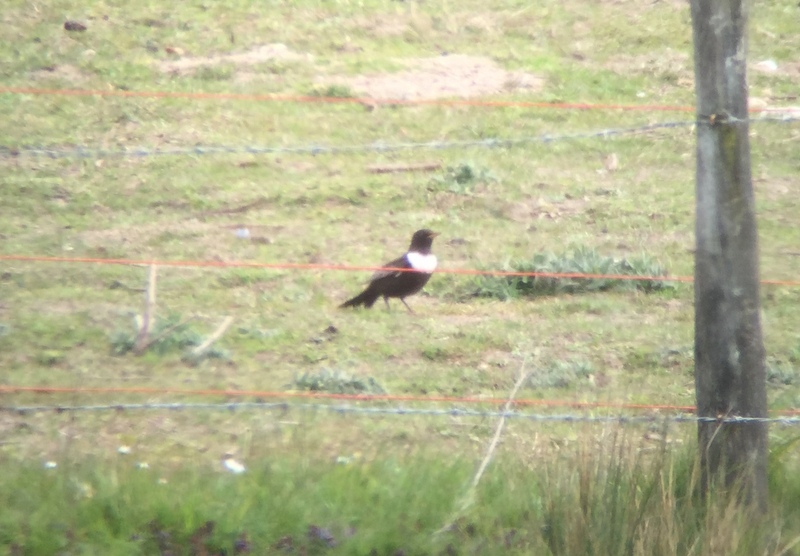 Ring Ouzel – in the field behind the Water Meadow
Ring Ouzel – in the field behind the Water Meadow
In between the showers, there were now some increasingly bright intervals, so we thought it might be worth a quick look up on the Heath, in some of the more sheltered spots. When we got there, it seemed rather quiet, despite being warm in places out of the wind. We had a quick walk round – the highlight was a single Adder slithering away into a tussock from the bank where it had been basking out of the wind. A couple of Buzzards circled high overhead. A Lesser Redpoll flew over, calling. A pair of Bullfinches were piping from the bushes by the car park. A Goldcrest was feeding up in a pine tree and a Willow Warbler was singing from the birches.
We moved swiftly on and made our way down to Cley for lunch. There were several people milling around in the car park as a Wryneck had been reported earlier, but it had not been seen by anyone after the first sighting. Just as most of the group headed into the visitor centre to make use of the facilities, a Hobby zipped overhead and stooped down after a couple of Meadow Pipits in the fields beyond, before disappearing over the hill behind North Foreland wood.
After lunch, we walked out onto the reserve. A Cetti’s Warbler was calling from the bushes and actually perched up in full view for a few seconds, before flying across the road and disappearing into cover again. A Sedge Warbler was singing from the top of the brambles but launched itself into song flight just as we got the scope onto it. A Water Rail squealed from out in the reeds.
As we settled into Teal Hide, we could see a nice selection of waders out on the scrape just in front. We were just working our way through them in turn, when we were distracted by a very smart black, summer plumage Spotted Redshank just behind them, so we had a good look at that first. There were also several Common Redshanks around for comparison and we had a good view of one in its rather more subtle summer plumage and one in winter still, side by side.
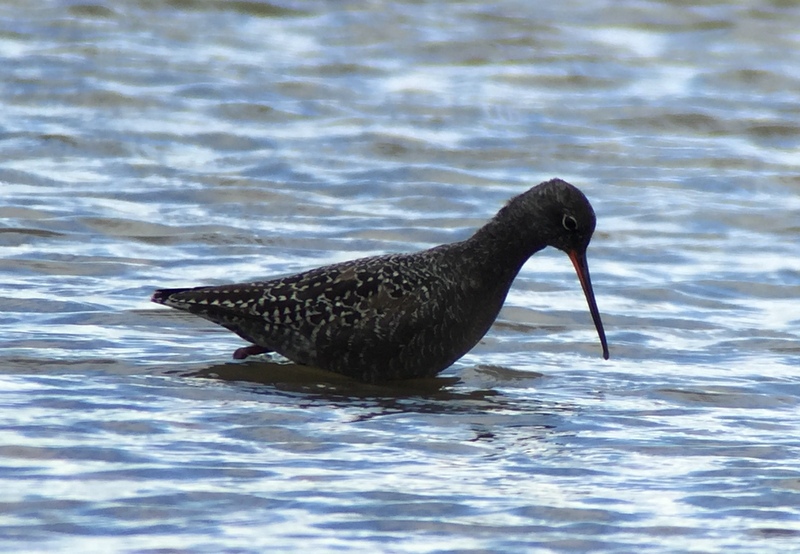 Spotted Redshank – looking very smart in summer plumage
Spotted Redshank – looking very smart in summer plumage
There were a couple of Ruff in front of the hide, both gradually moulting into their own summer plumage. Though yet to develop their characteristic ruffs, they were already looking rather different – one still rather grey-brown with black speckles and the chestnut headed with black bars. Ruff are the most variable wader in appearance.
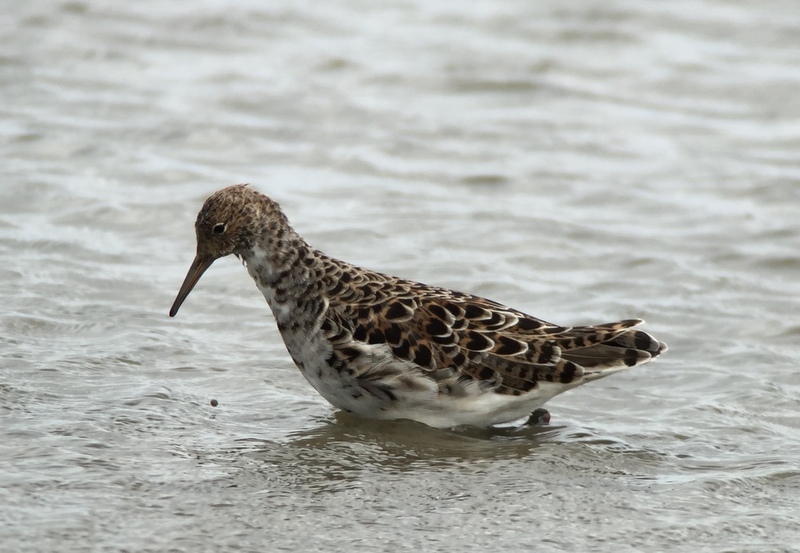
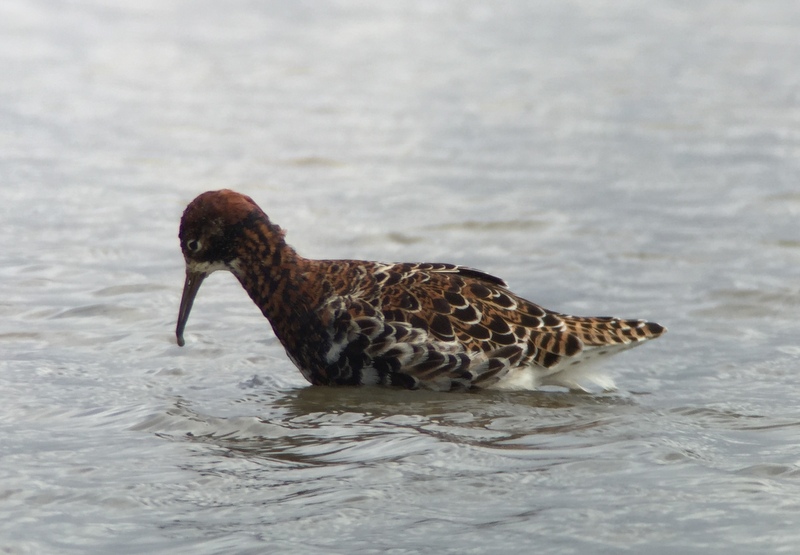 Ruffs – two rather different moutling males
Ruffs – two rather different moutling males
There were plenty of Avocets on here, as usual, and we watched one feeding right in front of the hide, sweeping its bill from side to side through the top of the mud.
 Avocet – this one was feeding in front of the hide
Avocet – this one was feeding in front of the hide
There is no shortage of Black-tailed Godwits at Cley either. Many are now also in summer plumage, with a striking rusty-orange head and breast. One particularly smart individual was feeding just in front of Dauke’s Hide when we got round there – it looked stunning when the sun came out. There were also about a dozen Dunlin on Simmond’s Scrape, one of which had already starting developing its summer black belly.
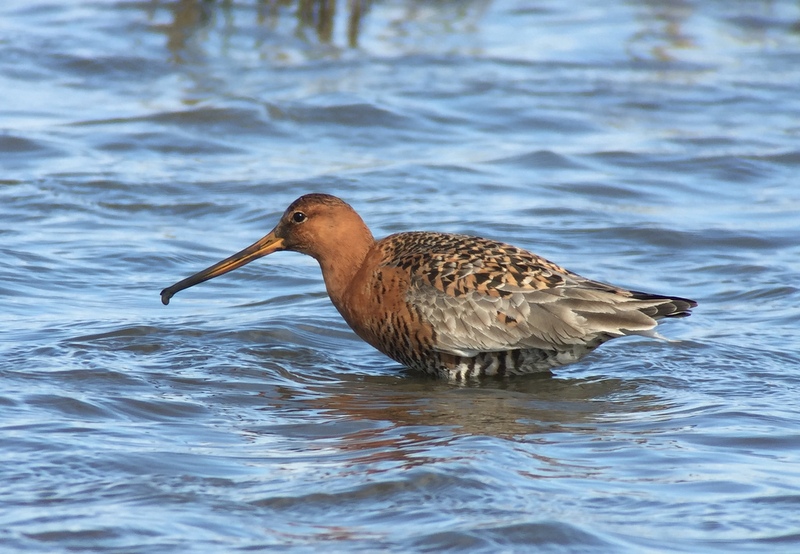 Black-tailed Godwit – a stunning summer-plumaged individual
Black-tailed Godwit – a stunning summer-plumaged individual
There are not so many ducks on the reserve now, with many having departed after the winter. A single drake Wigeon dropped in to Pat’s Pool at one point and a female Shoveler in the ditch in front of the hides was noted for its enormous shovel of a bill. A single male Marsh Harrier quartered over the reedbed at the back, in the wind.
 Shoveler – this female was showing off her enormous bill
Shoveler – this female was showing off her enormous bill
As the weather seemed to have improved a little, we decided to brave a walk round to the East Bank. We were almost round there when we heard a Whimbrel calling and looked up to see two flying away over the fields beyond. They appeared to be dropping down and from up on the Bank we could see them distantly out on the grass.
It is not normally advisable to go looking for Bearded Tits in the wind, as they generally stay well down in the reeds on days like this. So we were pleased initially just to hear a couple ‘pinging’ and get a glimpse of them zipping across and dropping back into the reeds. They appeared to have gone down into a channel through the reeds, so we walked along a short way to where we could look down along it from the Bank. There, down on a reed stem by the water, was a stunning male Bearded Tit. A female appeared too, and we watched the two of them creeping around in the reeds.
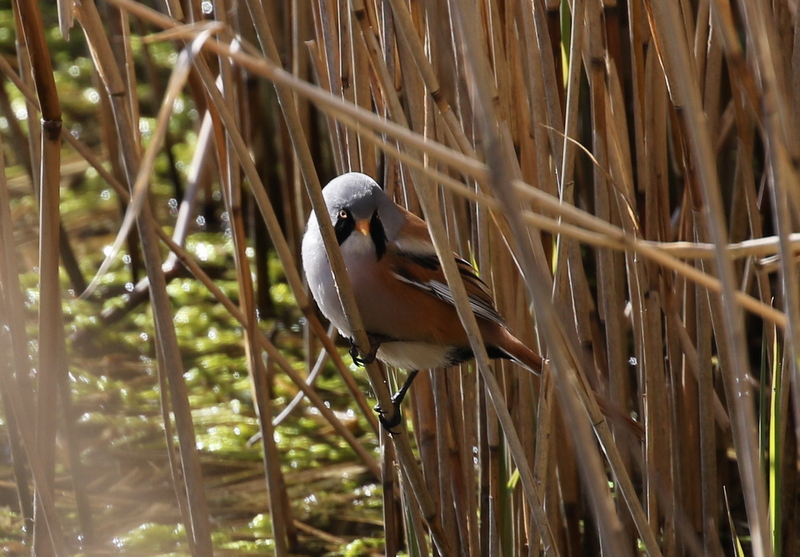 Bearded Tit – a stunning male, a nice surprise on a windy day
Bearded Tit – a stunning male, a nice surprise on a windy day
They disappeared out of view a couple of times, but kept coming back to the edge and worked their way right down towards us. Great stuff! Eventually, they just melted into the reeds.
There were three Little Ringed Plovers out on Pope’s Marsh and at first they wouldn’t settle, but kept flying round displaying. Eventually they all landed together. It appeared there might be two males, because they puffed their chests out and stood posturing at each other, while the third looked on. The Lapwings nest out on the grazing marshes here and they are now very aggressive, chasing after Crows, Redshanks, and even other Lapwings. There was also yet another differently coloured Ruff out on the Serpentine, this one with a pure white head.
Out at Arnold’s Marsh, there didn’t seem to be so many waders at first today. What was there were mostly Avocet and Redshank. A careful scan revealed a couple of Ringed Plovers out on the islands at the back and a Curlew was asleep out there too. There had been lots of Dunlin out here earlier in the week, and after a while a large flock flew in from the direction of the beach and proceeded to whirl round over the water, alternately flashing dull grey upperparts and bright white underneath.
We had seen a little group of four Sandwich Terns disappearing out over the shingle bank as we arrived, but standing in the new shelter here we heard more coming. Several singles or small groups flew in from the east, presumably having been out fishing further along the coast, and they continued straight overhead, back towards Blakeney Point.
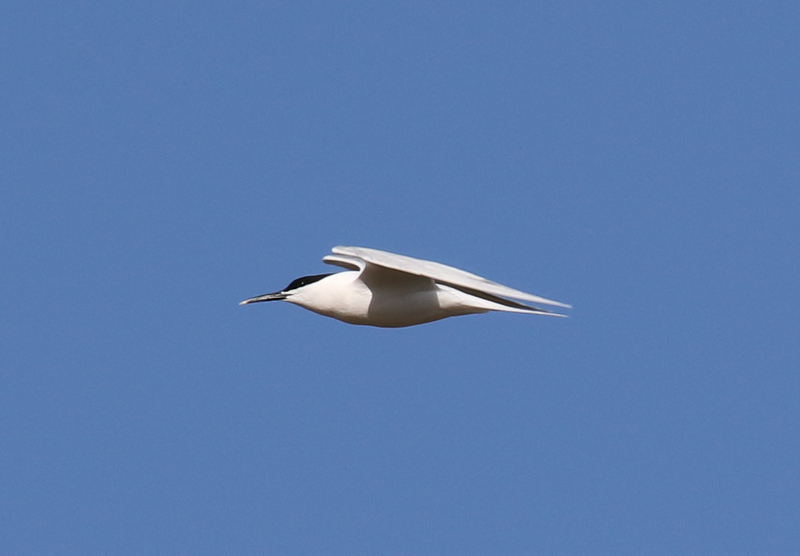 Sandwich Tern – several flew west this afternoon
Sandwich Tern – several flew west this afternoon
Then it was time to call it a day and head for home. We walked back with the sun shining – it was glorious now out here, even if it was still cool in the wind. We were almost back to the visitor centre when we stopped on the path to join someone waiting for the Water Voles to appear. We didn’t have to wait long – first one swam across to the other side, then a different one swam straight towards us. A lovely way to finish the day.
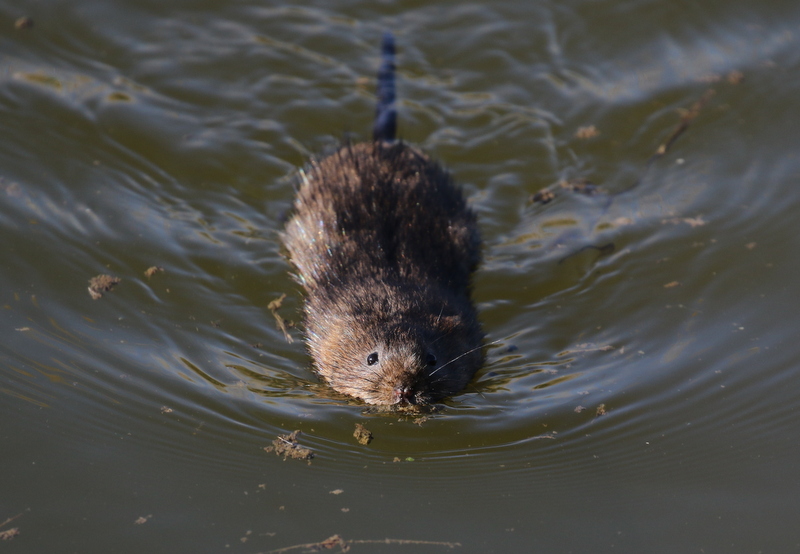 Water Vole – several were in the ditch
Water Vole – several were in the ditch
















